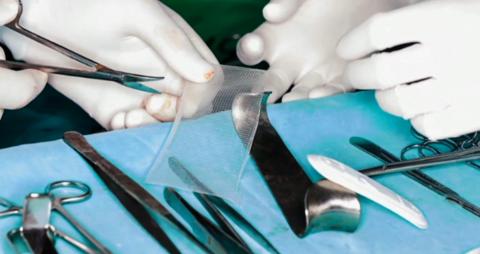Mesh: Denial, half-truths and the harms

In this article, Sharon Hartles critically discusses the harmful impacts of mesh medical devices against the backdrop of disempowerment, denial and half-truths. Sharon Hartles was awarded an MA in Crime and Justice (with distinction) from The Open University and is a member of the Harm and Evidence Research Collaborative.
Surgical meshes have been in use since the late 19th century. In the mid-20th century the clinical usage of mesh increased. Now, in the early 21st century, procedures involving mesh implantation are common surgeries that are performed around the world. Despite the frequency and worldwide usage of mesh medical devices, the debate about whether or not the benefits outweigh the alleged harms remains highly contested.
Mesh implants are manufactured from synthetic (non-absorbable or synthetic absorbable) and biological materials. Synthetic non-absorbable materials include: polypropylene, polyester, and polytetrafluorethylene. Synthetic absorbable materials include: polylactic-co-glycolic acid and polyhydroxybutyrate. Biological materials include: modified collagen of porcine or human dermal or visceral collagen.
Surgical (open) or laparoscopic (keyhole) approaches are carried out for the clinical applications of mesh implants. Mesh medical devices have been installed in breast reconstruction, abdominal/pelvic hernia repair, and hiatal hernia repair. Regardless of mesh implant technique and location, each material provides its own set of challenges. As such a complex range of potentially harmful side effects can occur.
The recent publication of the Independent Medicines and Medical Devices Safety Review (IMMDSR) report, First Do No Harm and the subsequent recommendations were welcomed by individuals and campaign groups effected by: mesh implants, Primodos and the anti-epilepsy drug sodium valproate. However, the mesh focus was centred on abdominal and vaginal pelvic mesh procedures used in the treatment of stress urinary incontinence and pelvic organ prolapse. For this reason the voices and lived experiences of many other mesh-harmed individuals, who did not fall into the particular focus, were not heard and did not form part of the IMMDSR publication.
Mesh-harmed individuals and campaigners experience traumatic, excruciating, unbearable pain and debilitating life changing harms, yet it is not only the medical devices that cause harm. Stubbornness and reluctance to blame implants in certain cases has led to doctors being accused of gaslighting - psychologically abusing mesh patients by questioning their sanity. This is exacerbated by flaws in the healthcare system, in some circumstances stemming from inexperience of professionals; gaps in research linking side effects to medical devices; and contested safety and efficiency status.
Dismissed as ‘women’s problems’, harms resulting from mesh implantations have been suppressed by doctors, leaving patients feeling belittled, ignored and above all disempowered. Relentless campaigning by patient groups has raised awareness of the lack of informed consent and a failure to listen to patients’ voices. In addition to this, campaigners have generated media and public interest into this injustice. This is not just localised to the UK, mesh surgeries are performed worldwide, and thus mesh-harmed activists are campaigning for justice around the world.
On 4th March 2021, in a landmark judgment, the Federal Court of Australia dismissed an appeal by Johnson & Johnson (one of the main manufacturers of vaginal mesh), who was found to have acted negligently. Johnson & Johnson concealed known complications about mesh implants and aggressively marketed their faulty implants successfully based on half-truths. A clear case of profit before harm, Johnson & Johnson had no regard for the serious and debilitating side effects thousands of women would experience from their mesh devices; and instead was driven by profiteering and commercial interests.
Although it is overwhelmingly women’s voices which have been ignored and women’s lived experiences which (until recently) have not been validated; it is paramount to note that mesh medical devices are also implanted into men, children and babies. Therefore it stands to reason that the devastating impacts of mesh are not just experienced by women. In December 2018, Graham Robertson, was left with a multitude of serious health complications, allegedly stemming from hernia surgery in 2007. While he experienced chronic pain, professional responses to his situation ranged from dismissal to denial. From the doctors’ perspectives the hernia had not returned, thus demonstrating the success of the procedure. Yet, despite the successful nature of the surgery, in this case, the side effects outweighed the benefits.
The responses to many questions remain contested or disputed at this time, such as:
-
Do the long-term benefits of mesh medical devices outweigh the risks (side effects)?
-
How is reasonable assurance of safety and effectiveness of mesh medical devices measured?
-
What practices are in place (locally and globally) to ensure patient voices are listened to and acted upon?
-
What systems are in place to deter companies from favouring profit and commercial gain above the interest of patient safety?
Nevertheless what is apparent is the need to ensure patients are able to make informed decisions about their healthcare and well-being. In order to do this patients must be fully informed about the risks. Beyond this, a patient-led approach must be centred at the heart of future health care procedures and provision. The hope is that such an approach will guarantee the focus remains on patient safety first; and deters other agendas which would potentially conflict with the best interests of patients.
There are a number of mesh campaign groups throughout the UK and globally which offer general advice and support to individuals affected by mesh harms. Groups include:
Photo Credit: BBC Two Victoria Derbyshire 15th January 2020
